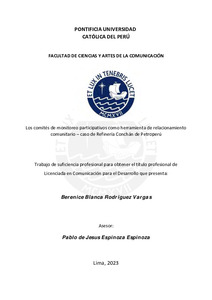| dc.contributor.advisor | Espinoza Espinoza, Pablo de Jesus | |
| dc.contributor.author | Rodriguez Vargas, Berenice Blanca | |
| dc.date.accessioned | 2023-05-02T15:46:41Z | |
| dc.date.available | 2023-05-02T15:46:41Z | |
| dc.date.created | 2023 | |
| dc.date.issued | 2023-05-02 | |
| dc.identifier.uri | http://hdl.handle.net/20.500.12404/24851 | |
| dc.description.abstract | El objetivo del presente trabajo es mostrar los beneficios de contar con un canal de
comunicación entre una empresa y la poblacione aledaña. Nos centraremos en el estudio de
los Comités de Monitoreo Socioambiental Participativos, los cuales congregan a una empresa
de la industria de hidrocarburos y una población aledaña. Tal Comité tiene el fin de
posibilitar el intercambio —sin temor— de información de interés compartido con relación a
los impactos negativos o positivos que la empresa tiene hacia la población aledaña, esto con
la idea de tener una relación constructiva y comprensiva basada en dos principios: la
transparencia y la oportunidad de dicha información. El periodo sobre el cual se sistematiza
la experiencia es entre el 2016 y 2021.
Los comunicadores para el desarrollo que trabajamos en áreas de relaciones comunitarias
necesitamos de herramientas para acercarnos a la comunidad y acercar la empresa a la
comunidad.
Entonces, el objetivo es describir el Programa de Monitoreo Socioambiental Participativo y
señalar cómo esperaríamos que sean para que el proceso se desarrolle de manera ideal, con el
fin de analizar y recomendar ajustes en el modelo.
Una intervención como esta requiere que la empresa reciba con apertura sugerencias y
comentarios, y que estos sean una fuente para la autocrítica e insumo para la mejora continua.
Finalmente, este trabajo se propone evaluar el potencial que ha emergido con un grupo
cohesionado, para abordar otros temas de índole social, económico y ambiental, y ello como
palanca para el desarrollo de las propias comunidades aledañas. | es_ES |
| dc.description.abstract | The objective of this work is to show the benefits of having a communication channel
between a company and the surrounding population. We will focus on the study of the
Participatory Socio-environmental Monitoring Committees, which bring together a company
from the hydrocarbon industry and the surrounding population. Such Committee is intended
to enable the exchange —without fear— of information of shared interest in relation to the
negative or positive impacts that the company has on the surrounding population, with the
idea of having a constructive and comprehensive relationship based on two principles:
transparency and timeliness of said information. The period over which the experience is
systematized is between 2016 and 2021.
Communicators for development who work in the areas of community relations need tools to
get closer to the community and to bring the company closer to the community.
Then, the objective is to describe the Participatory Socio-environmental Monitoring Program
and point out how we would expect them to be so that the process develops in an ideal way,
in order to analyze and recommend adjustments to the model.
An intervention like this requires that the company openly receive suggestions and
comments, and that these be a source for self-criticism and input for continuous
improvement.
Finally, this work intends to evaluate the potential that has emerged with a cohesive group, to
address other issues of a social, economic and environmental nature, and this as an impulse
for the development of the surrounding communities. | es_ES |
| dc.language.iso | spa | es_ES |
| dc.publisher | Pontificia Universidad Católica del Perú | es_ES |
| dc.rights | info:eu-repo/semantics/openAccess | es_ES |
| dc.rights.uri | http://creativecommons.org/licenses/by-sa/2.5/pe/ | * |
| dc.subject | Participación ciudadana | es_ES |
| dc.subject | Impacto ambiental | es_ES |
| dc.subject | Comunicación--Aspectos sociales--Perú | es_ES |
| dc.title | Los comités de monitoreo participativos como herramienta de relacionamiento comunitario – caso de Refinería Conchán de Petroperú | es_ES |
| dc.type | info:eu-repo/semantics/bachelorThesis | es_ES |
| thesis.degree.name | Licenciado en Comunicación para el Desarrollo | es_ES |
| thesis.degree.level | Título Profesional | es_ES |
| thesis.degree.grantor | Pontificia Universidad Católica del Perú. Facultad de Ciencias y Artes de la Comunicación. | es_ES |
| thesis.degree.discipline | Comunicación para el Desarrollo | es_ES |
| renati.advisor.dni | 25664353 | |
| renati.advisor.orcid | https://orcid.org/0000-0002-6367-1528 | es_ES |
| renati.author.dni | 43324234 | |
| renati.discipline | 322186 | es_ES |
| renati.juror | Macassi Lavander, Sandro Enrique | es_ES |
| renati.juror | Espinoza Espinoza, Pablo de Jesus | es_ES |
| renati.juror | Morales Bermudez, Clara Wiese | es_ES |
| renati.level | https://purl.org/pe-repo/renati/level#tituloProfesional | es_ES |
| renati.type | https://purl.org/pe-repo/renati/type#trabajoDeSuficienciaProfesional | es_ES |
| dc.publisher.country | PE | es_ES |
| dc.subject.ocde | https://purl.org/pe-repo/ocde/ford#5.08.04 | es_ES |







